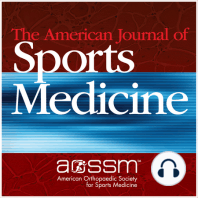6 min listen

AJSM September 2020 Podcast: The Hip Suction Seal, Part I and II
AJSM September 2020 Podcast: The Hip Suction Seal, Part I and II
ratings:
Length:
13 minutes
Released:
Aug 31, 2020
Format:
Podcast episode
Description
The acetabular labrum has been found to provide a significant contribution to the distractive stability of the hip. However, the influence of labral height on hip suction seal biomechanics is not known. In conclusion, smaller height (<6 mm) of the acetabular labrum was significantly associated with decreased distance to suction seal rupture and decreased peak negative pressure. A new strategy to increase the size of the labrum, such as labral augmentation, could be justified for patients with smaller labra in order to optimize the hip suction seal. Click here to read Part I. The acetabular labrum contains free nerve endings, and an unstable labrum can result in increased femoral head movement during hip motion. This can be caused by chondrolabral junction (CLJ) separation, especially in association with pincer-type femoroacetabular impingement, and may contribute to hip pain. In conclusion, rim trimming did not change the biomechanical properties of the labral suction seal. Labral refixation resulted in a shorter distance to break the labral suction seal. This indicates that labral mobility is reduced by the labral refixation procedure, which could be beneficial in postoperative pain relief and labral healing. Click here to read Part II.
Released:
Aug 31, 2020
Format:
Podcast episode
Titles in the series (100)
AJSM June 2020 5-in-5 Podcast: Five articles from the June 2020 issue summarized in five minutes, with the addition of a brief editorial commentary. The 5-in-5 feature is designed to give readers an overview of articles that may pique their interest and encourage more detailed... by American Journal of Sports Medicine